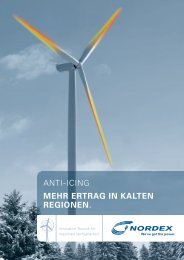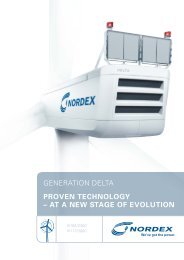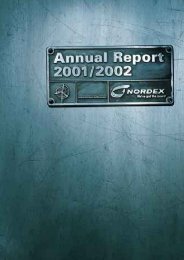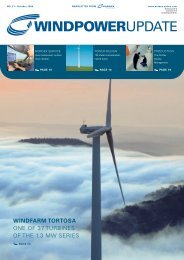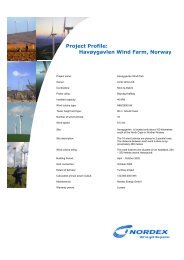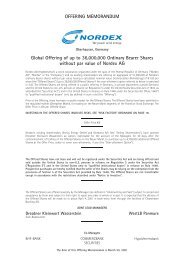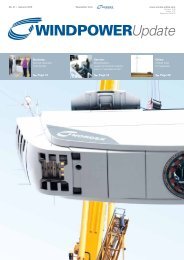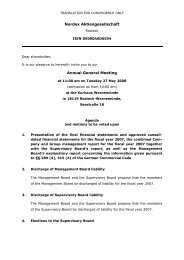Download WindpowerUpdate 15 - Nordex
Download WindpowerUpdate 15 - Nordex
Download WindpowerUpdate 15 - Nordex
Create successful ePaper yourself
Turn your PDF publications into a flip-book with our unique Google optimized e-Paper software.
The time of large-scale power plants has passed.<br />
The 1,000 MW blocks driven by fossil fuels and<br />
nuclear power stations are gradually disappearing<br />
from the scene. The reason: they are too expensive<br />
and inflexible for the energy production of the future.<br />
For this reason, today more and more suppliers<br />
are making use of a mix of decentralized energy producers.<br />
In this way it is possible to generate electricity<br />
and heat locally and thus avoid energy losses<br />
resulting from long transport distances. In addition<br />
to this, decentralized power-plant structures are able<br />
to react more flexibly.<br />
However, in order to be able to guarantee a secure<br />
power supply, an intelligent control system is<br />
required for the distributed units. Here, the key concept<br />
is the “virtual power plant”. A topic which is<br />
now also being worked on by the experts of Natcon7,<br />
a subsidiary of <strong>Nordex</strong> AG. “We want to produce the<br />
first prototype of energy with the aid of wind power,<br />
solar energy, photovoltaics, hydro power, biomass,<br />
biogas and geothermal heat. The use of these renewables<br />
and the conversion into electricity and heat is<br />
effected at different locations. The distributed energy<br />
producers are run as an intelligent association<br />
by means of special automation and information<br />
technologies”, explains Dirk Adam, CEO of Natcon7.<br />
The combination of many decentralized energy<br />
producers to form a virtual power plant ensures a secure<br />
supply and is extremely economically efficient.<br />
An existing virtual power plant can be extended to<br />
include further producers at any time. The location<br />
is of no consequence. As a virtual power plant is completely<br />
neutral in terms of technology, machines<br />
made by different manufacturers can be integrated<br />
into the association.<br />
The combination of many decentralized energy producers to<br />
form a virtual power plant ensures a secure supply and is<br />
extremely economically efficient.<br />
The virtual power plant reacts much more flexibly in changing<br />
energy demand than the conventional large power station is<br />
able to.<br />
This means that the road is clear for a mixture of<br />
renewables. The combination of different forms of<br />
renewable energy offers enormous advantages for<br />
the operator as fluctuations in supply and demand,<br />
resulting from weather conditions or changes in<br />
energy consumption, for example, are easy to compensate<br />
for. Here, it is important to also include permanently<br />
available producers, such as biomass and<br />
CHP (combined heat and power) plants, as well as –<br />
in the future – fuel cells. This makes it possible for a<br />
virtual power plant to react much more flexibly in<br />
changing energy demand than a conventional large<br />
power station is able to.<br />
Each integrated producer is connected to the supply<br />
grid and has his own control system which<br />
is in direct contact, via an interface, with the central<br />
control system of the virtual power plant. As a result<br />
of this connection, the central control system knows<br />
which individual and total capacity is currently available.<br />
The central control system is equipped with<br />
further communication interfaces, via which it is provided<br />
with additional information. For example, the<br />
central control system is able to evaluate weather<br />
forecasts for the individual locations as well as data<br />
on the current and expected demand situation on<br />
the energy market. The sale of surplus electricity on<br />
the energy exchange is included. This means that<br />
the central control system is in a position to coordinate<br />
the power generation of the association<br />
efficiently and in line with demand on the basis of<br />
reliable information.<br />
?<br />
Did You Know That...<br />
• from October to December this year, <strong>Nordex</strong> installs almost 2 wind<br />
turbines each day in each week somewhere in the world.<br />
• the wind energy sector uses 300,000 tonnes more steel than the German<br />
ship building industry.<br />
• in France, trucks with <strong>Nordex</strong> wind turbine parts of up to 29 metres<br />
had to pass over a local petanque field in order to get through a very<br />
narrow turn. This was done according to an agreement with the mayor<br />
of the village, and of course, <strong>Nordex</strong> rebuilt the petanque field after<br />
use.<br />
• during the last decade, the investment costs in a wind turbine have<br />
been deducted with more than 50 %.<br />
• the wind energy saves external costs corresponding to an amount of<br />
2.5 – 20 Ct/kWh.<br />
No. <strong>15</strong> ı December 2002 7




